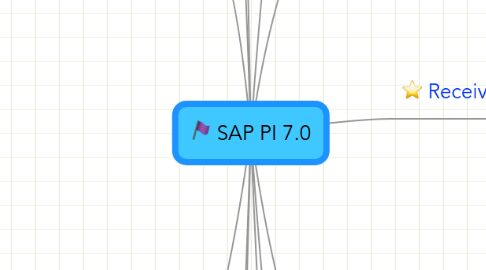
1. Adapter Framework
2. Message Interface
2.1. located in the Integration Repository
2.2. highest-level component of an interface
2.3. PI interfaces go from one Message Interface to another
2.4. specifies
2.4.1. direction
2.4.1.1. inbound
2.4.1.2. outbound
2.4.2. interface pattern
2.4.2.1. synchronous
2.4.2.2. asynchronous
2.4.3. Message Type
2.5. can be built from external definitions
2.5.1. modifiable
2.5.1.1. XSD
2.5.1.2. DTD
2.5.2. not modifiable (need re-import)
2.5.2.1. IDoc
2.5.2.2. RFC
2.5.2.3. WSDL
2.6. uniquely identified by
2.6.1. Business System
2.6.2. Message Interface name
2.6.3. Namespace
2.6.3.1. any valid URI
3. Integration Builder
3.1. Runs in Java stack
3.2. Integration Repository
3.2.1. design-time environment
3.2.1.1. reusable objects, data types, etc.
3.2.1.2. Enterprise Services Repository in PI 7.1
3.2.2. organised by Software Component Version
3.2.3. contains
3.2.3.1. Message Types
3.2.3.2. Data Types
3.2.3.3. Message Interfaces
3.2.3.4. Mapping Programs
3.2.3.5. imported IDocs
3.2.3.6. imported RFCs
3.2.3.7. Integration Scenario
3.2.3.7.1. graphical high-level view of integration process
3.2.3.7.2. ARIS integration possible
3.2.3.7.3. BPEL compatible
3.3. Integration Directory
3.3.1. configuration-time environment
3.3.2. organised by
3.3.2.1. object type
3.3.2.1.1. namespace
3.3.2.2. configuration scenario
3.3.3. contains
3.3.3.1. Configuration Scenario
3.3.3.1.1. logical collection of Directory objects
3.3.3.1.2. can be cross-namespace
3.3.3.1.3. useful for transporting objects together
3.3.3.2. Value mapping table tool
3.3.3.3. Communication channels
3.3.3.4. Receiver Determinations
3.3.3.5. Interface Determinations
3.3.3.6. Sender Agreements
3.3.3.7. Receiver Agreements
3.3.3.8. Business Services
3.3.3.8.1. not transportable
3.3.3.8.2. not in the SLD
3.3.3.8.3. cannot define landscapes - single service
3.3.3.8.4. useful for external web services
3.3.3.9. Party
3.3.3.9.1. each external B2B partner should be set up here
3.3.3.9.2. can define unique partner IDs
3.3.3.9.3. assigns
4. NetWeaver
4.1. 7.0 version
4.2. ABAP Stack
4.2.1. Integration Server
4.2.2. ccBPM/Workflow Engine
4.2.3. Internet Connection Manager (ICM)
4.3. Java Stack
4.3.1. Integration Builder tools
4.3.2. Runtime Workbench
4.3.3. Mapping engine
4.3.3.1. except for ABAP mapping programs and XSLT (ABAP)
4.3.4. Adapter Engine
4.3.4.1. can be run on a separate server with a Java Stack
4.4. Database
4.4.1. Java schema
4.4.2. ABAP schema
5. Mapping
5.1. structure mapping
5.1.1. transforms one XML document into another
5.1.2. change field names or hierarchial structures
5.2. value mapping
5.2.1. modification of values in message fields
5.2.2. can use value mapping tables
5.2.2.1. manually created & updated in Integration Directory
5.2.2.2. uploaded through HTTP adapter
5.2.2.3. visible in Runtime Workbench
5.2.3. generally performance impact
5.3. implemented in
5.3.1. Graphical mapping program
5.3.2. XSLT
5.3.2.1. can run in Java or ABAP stack
5.3.2.2. Java stack is more standards-based
5.3.2.3. XSLT 1.0 only
5.3.3. Java
5.3.4. ABAP
6. Alert Framework
7. ccBPM
7.1. runs in ABAP stack
7.1.1. based on SAP Workflow
7.2. also called Integration Process
7.3. designed in the Integration Repository
7.4. belong to a Software Component
7.5. Once designed, needs to be imported into the Integration Directory
7.5.1. define Business Systems connecting to process
8. SLD
8.1. can be automatically updated from another SAP system
8.1.1. ABAP Systems: via RZ70
8.1.2. Java Systems: via Data Supplier Service
8.2. Business Systems
8.2.1. can be associated to 1+ comms channels
8.2.1.1. mandatory for Receiver channels
8.2.1.2. optional for Sender channels (HTTP adapter can be used to bypass)
8.2.2. groups can be used to associate Business Systems across multiple SLDs
8.2.2.1. e.g. group ERP_DEV and ERP_PRD into a group called ERP.
8.2.2.2. This is useful for transporting objects
8.2.3. 1 to 1 mapping to Technical Systems
8.2.3.1. exception: ABAP systems; each has its own Business System and Technical System
8.2.3.2. ability to down-select installed products
8.2.4. Ability to associate to an integration server
8.2.4.1. used to align system landscapes with PI
8.2.4.2. landscapes are defined separately in the SLD
8.2.5. define transport sources & targets
8.2.6. Integration generally occurs between 2 Business Systems
8.3. Technical Systems
8.3.1. defines
8.3.1.1. hostname
8.3.1.2. Products
8.3.1.2.1. linked to Software Component Versions
8.3.1.2.2. Software Components can be assigned selectively
8.3.1.3. SID (for ABAP systems)
8.4. Product Catalogue
8.4.1. defines
8.4.1.1. Products
8.4.1.1.1. Linked to Technical Systems
8.4.1.2. Software Component Versions
8.5. does not contain Business Services
8.5.1. these are defined in the Integration Directory only
8.5.2. single-instance services without the ability to have a landscape (i.e. dev, test, prod)
9. Receiver Determination
9.1. part of logical routing
9.2. defines either
9.2.1. Sender Service
9.2.2. Receiver Service
9.2.3. both
9.2.4. this information is taken from the envelope of the message received by PI
9.3. Message Split
9.3.1. duplicate incoming message and forward to 1 or more receivers
9.3.2. routing based on
9.3.2.1. content
9.3.2.2. envelope information
9.3.3. creates new entries in SXMB_MONI
9.4. Content-based Routing
9.4.1. significant performance impact
9.4.2. XPath logic
9.4.2.1. multiple conditions
9.4.2.2. logical AND, OR, etc.
9.5. best starting point for trouble shooting
9.5.1. central part of an interface
9.5.2. good end to end visibility
10. Message Type
10.1. highest-level XML document for an interface
10.2. can be imported from an XSD
10.3. contains one or more Data Types
10.3.1. based on standard XSD data types
10.3.2. can contain other Data Types
10.3.2.1. for nested XML, i.e. complex Data Type
10.3.3. can be Context Objects
10.3.3.1. XPath variables based on other XML documents
10.3.3.2. reusable
11. Runtime Workbench
11.1. End to End monitoring
11.1.1. Untitled
11.2. Cache monitoring
11.3. Message monitoring
11.4. Performance monitoring
11.4.1. statistics
11.4.1.1. throughput (messages/hour)
11.4.1.2. latency (between receive and send)
11.4.2. includes adapter engines
11.4.3. can link to other ABAP systems if proxies defined
